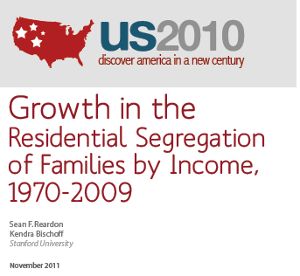US Growth in the Residential Segregation of Families by Income, 1970-2009
Documents
us-housing-segregation-report111111
Growth in the Residential Segregation of Families by Income, 1970-2009
Report Abstract
As overall income inequality grew in the last four decades, high- and low-income families have become increasingly less likely to live near one another. Mixed income neighborhoods have grown rarer, while&nbsuent and poor neighborhoods have grown much more common. In fact, the share of the population in large and moderate-sized metropolitan areas who live in the poorest and muent neighborhoods has more than doubled since 1970, while the share of families living in middle-income neighborhoods dropped from 65 percent to 44 percent.
The residential isolation of the both pouent families has grown over the last fouent families have been generally more residentially isolated than poor families during this period. Income segregation among African Americans and Hispanics grew more rapidly than among non-Hispanic whites, especially since 2000.
These trends are consequential because people are aected by the character of the local areas in which they live. The increasing concentration of income and wealth (and therefore of resources such as schools, parks, and public services) in a small number of neighborhoods results in greater disadvantages for the remaining neighborhoods where low- and middle-income families live.

